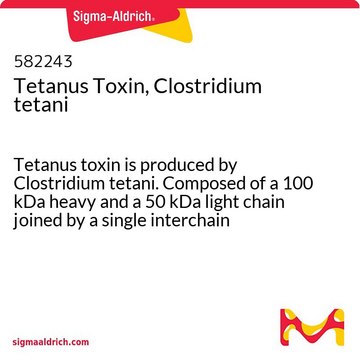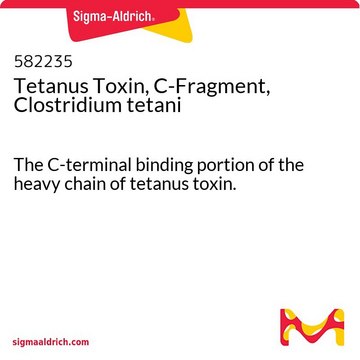T3694
Tetanus toxin C fragment from Clostridium tetani
Sinônimo(s):
TTC
Faça loginpara ver os preços organizacionais e de contrato
About This Item
Produtos recomendados
peso molecular
apparent mol wt 47 kDa
Nível de qualidade
cor
white
solubilidade
H2O: soluble
temperatura de armazenamento
2-8°C
Descrição geral
Tetanus toxin C fragment (TTC) is a non-toxic peptide, which is transported from peripheral axons into spinal motoneurons. It provides protection for motoneurons (MN) in the spinal cord in vivo. TTC regulates membrane binding, internalization and retrograde transport within MN. It initiates neurotrophin-regulated signaling pathways in a Trk receptor-dependent manner. TTC has neuroprotective property in primary cerebellar granule cell culture.
Aplicação
The C terminal binding portion of tetanus toxin is not toxic but is taken up by pre-synaptic nerve terminals and exhibits trans-synaptic retrograde transport in central neurons similar to that of tetanus toxin. It is used to map neuronal connections and to target proteins to neurons.
Ações bioquímicas/fisiológicas
Tetanus toxin is a neurotoxin that comprises of a heavy and a light chain linked by disulfide bridges. This neurotoxin enters the cytoplasm and releases the light chain component that subsequently inhibits the release of neurotransmitters2. Studies have reported that the fragment C of tetanus toxin retains most of the determinants that interact with thyroid membranes, gangliosides and neural membranes3.
Reconstituição
Each vial, when reconstituted with 50 μl of sterile distilled water, contains 10 μg of tetanus toxin C-fragment in 0.01 M sodium phosphate, pH 7.5. To aid recovery, 0.1% albumin may be added.
Palavra indicadora
Danger
Frases de perigo
Declarações de precaução
Classificações de perigo
Acute Tox. 1 Oral - Acute Tox. 2 Inhalation - STOT SE 1
Órgãos-alvo
Central nervous system
Código de classe de armazenamento
6.1A - Combustible acute toxic Cat. 1 and 2 / very toxic hazardous materials
Classe de risco de água (WGK)
WGK 3
Ponto de fulgor (°F)
Not applicable
Ponto de fulgor (°C)
Not applicable
Escolha uma das versões mais recentes:
Já possui este produto?
Encontre a documentação dos produtos que você adquiriu recentemente na biblioteca de documentos.
T B Helting et al.
The Journal of biological chemistry, 252(1), 187-193 (1977-01-10)
Tetanus toxin was digested with papain, yielding one major polypeptide (Fragment C) with a molecular weight corresponding to 47,000 +/- 5%, thus comprising about one-third of the toxin molecule. Fragment C was antigenically active, atoxic, and stimulated the formation of
Tetanus toxin C-fragment protects against excitotoxic spinal motoneuron degeneration in vivo
Netzahualcoyotzi C and Tapia R
Scientific Reports, 8(1), 16584-16584 (2018)
Interaction of fragments B and C of tetanus toxin with neural and thyroid membranes and with gangliosides.
N P Morris et al.
The Journal of biological chemistry, 255(13), 6071-6076 (1980-07-10)
E Link et al.
Biochemical and biophysical research communications, 189(2), 1017-1023 (1992-12-15)
Tetanus toxin is a potent neurotoxin that inhibits the release of neurotransmitters from presynaptic nerve endings. The mature toxin is composed of a heavy and a light chain that are linked via a disulfide bridge. After entry of tetanus toxin
Nossa equipe de cientistas tem experiência em todas as áreas de pesquisa, incluindo Life Sciences, ciência de materiais, síntese química, cromatografia, química analítica e muitas outras.
Entre em contato com a assistência técnica








